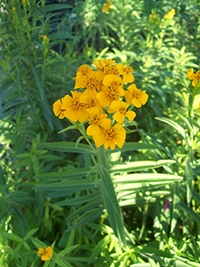Table of Contents

The tarragon plant is aromatic and is one of the few that does not grow wild in Mediterranean countries; thus, it was not known in the classical ages. The Arabs brought it to Spain between the 9th and 10th centuries. From there, its cultivation spread to the rest of Europe and America.
Tarragon is highly appreciated as a seasoning in French cuisine. However, its medicinal properties make this plant more than just a simple spice.
Tarragon Plant Scientific Facts
- Other names: Estragon.
- French: Estragon.
- Spanish: Estragon.
- Environment: Native to Central Asia, though cultivated and sometimes growing wild all over Europe and some American Countries.
- Description: Vivacious, aromatic plant of the Compositae family, growing from 60 to 80 cm high, with lanceolate leaves and yellowish flowers that gather in small, spherical heads.
- Parts used: Leaves and flower heads.
Healing Properties and Warning

The whole plant contains an essential oil rich in estragol, phelandren, ocymen, and hydroxycoumarin. Its properties are as follows:

- Appetizer, digestive, and carminative (eliminates intestinal gas).
- Antiseptic on pathogenic germs of the digestive tract.
- Emmenagogue: It stimulates menstruation.
- Vermifuge: It expels intestinal parasites.
Tarragon is thus recommended for lack of appetite, bloated stomach, flatulence, intestinal fermentation, and intestinal parasites.
WARNING! Never exceed the recommended dose of the essence since it can produce an intense stimulation of the nervous system.
How to use Tarragon
- Seasoning: In salads and all kinds of meals.
- Infusion with 30g of plant per liter of water. Drink a cup before each meal as an appetizer and after each meal as a digestive.
- Essence: The recommended dose is from three to five drops, three times a day.
Frequently Asked Question
I’ve heard the tarragon plant may help regulate blood sugar. How does this work?
Research suggests that tarragon might improve insulin sensitivity. Animal studies indicate potential benefits for blood glucose management, but more human clinical trials are needed to understand its impact fully.
Can the tarragon plant help with pain relief?
Traditionally, tarragon has been used in folk medicine to alleviate pain. Animal studies indicate extracts from Artemisia plants (the genus tarragon belongs to) might hold pain-relieving properties.
Does the tarragon plant have antioxidant properties?
Yes, tarragon contains antioxidants like flavonoids and phenolic acids. These chemicals may have a function in lowering the risk of chronic illnesses by protecting cells from free radical damage.
I have sleep issues. Could tarragon help?
Anecdotal reports and limited studies suggest the tarragon plant might have mild sedative properties, potentially promoting relaxation and improving sleep quality.
Can tarragon improve appetite?
Are there any digestive benefits to using tarragon?
Does tarragon hold any antimicrobial benefits?
Preliminary research indicates the essential oils in tarragon might have some antimicrobial properties.
Are there cardiovascular benefits to tarragon?
Tarragon is a good source of potassium, a mineral essential for heart health. Potassium helps regulate blood pressure. Additionally, the antioxidants in tarragon might indirectly support cardiovascular health by reducing inflammation.
Could tarragon have a role in skin healing?
A 2020 study suggests topical applications of tarragon might help address skin wounds and irritations.
Is it safe to include tarragon in my daily diet?
Tarragon is generally considered safe when consumed in amounts typical for cuisine. However, some individuals might be allergic to it. Always check with your doctor before making any significant changes to your diet if you’re worried about your health.
DISCLAIMER: All content on this website is presented solely for educational and informational objectives. It would be best to not rely on the information provided as a replacement for advice, diagnosis, or treatment from a qualified medical expert. If you are pregnant, nursing, or have any preexisting medical concerns, you should talk to your doctor before using any herbal or natural medicines.
REFERENCES
- George D. Pamplona-Roger, M.D. “Encyclopedia of Medicinal Plants.” George D. Pamplona-Roger, M.D. Encyclopedia of Medicinal Plants. Ed. Francesc X. Gelabert. vols. 2 San Fernando de Henares: Editorial Safeliz, 2000. 430. Print. [tarragon plant]
- https://www.healthline.com/nutrition/tarragon-benefits-uses
- https://www.webmd.com/vitamins/ai/ingredientmono-661/tarragon
- https://www.rxlist.com/supplements/tarragon.htm
- https://www.verywellfit.com/tarragon-benefits-side-effects-and-preparations-4179022
Last update on 2024-07-22 / Affiliate links / Images from Amazon Product Advertising API

